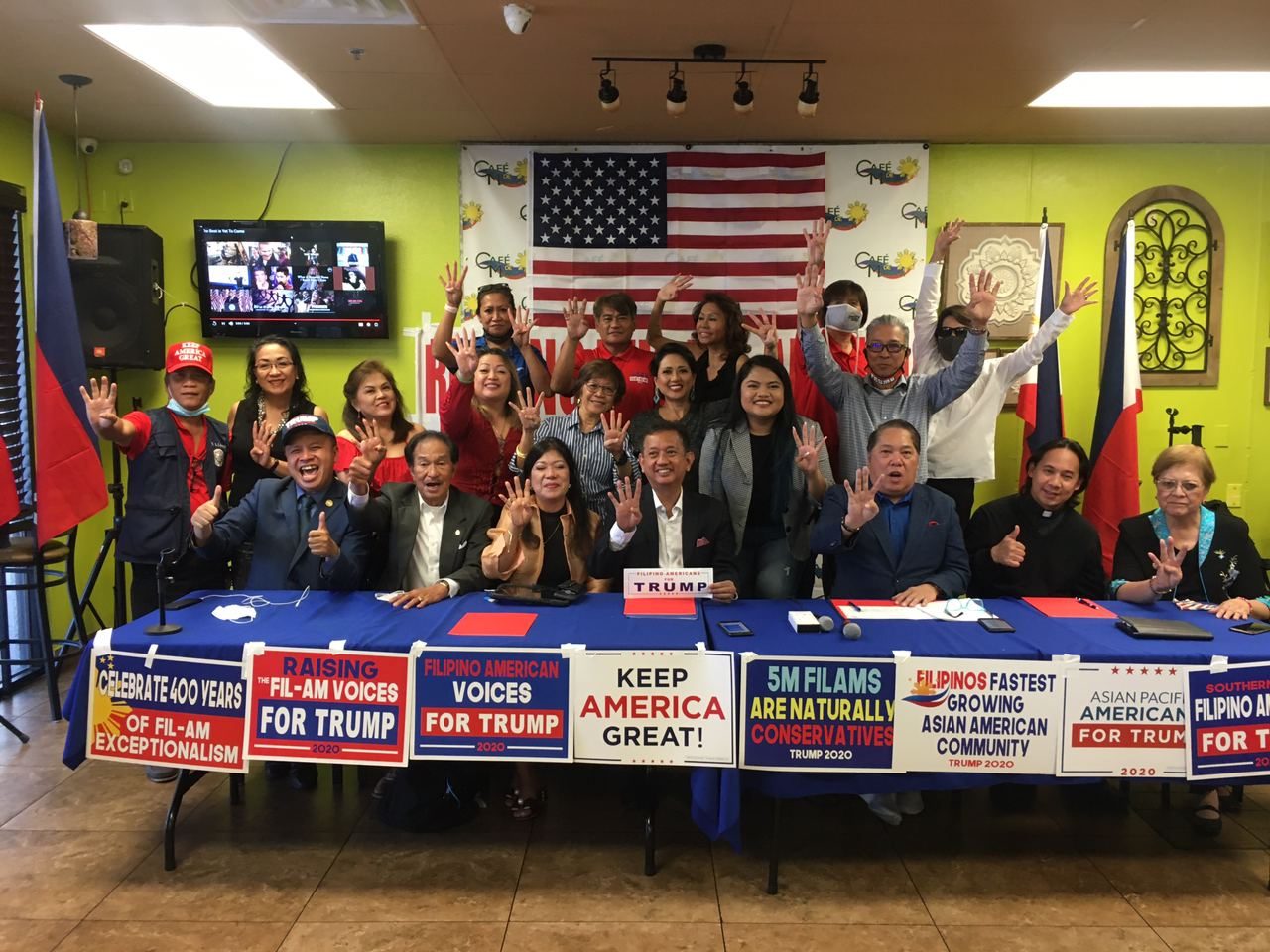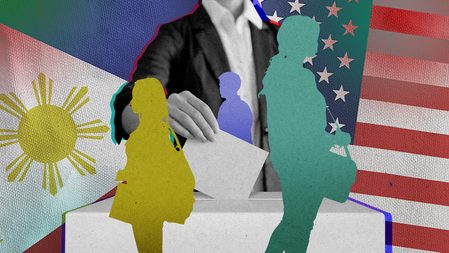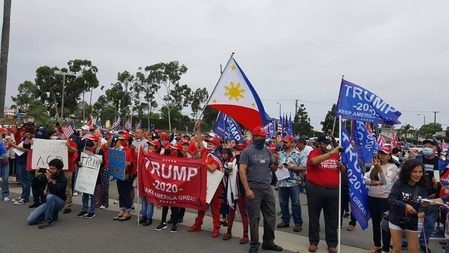SUMMARY
This is AI generated summarization, which may have errors. For context, always refer to the full article.

It’s been a nail-biting race to 270 in the 2020 election for incumbent United States President Donald Trump and his Democrat rival, Joe Biden.
As of November 5, 5:30 am Manila time, Biden leads in the race, just short of 6 electoral votes before reaching 270. But thousands of votes have yet to be counted in several battleground states, and Trump is treading close.
In a country known historically to open its doors to immigrants looking to achieve the American Dream, more than 20 million Asian Americans stand out as the fastest-growing segment of eligible voters among major ethnic groups, according to the Pew Research Center. These include Filipinos as one of the largest subgroups. (READ: A growing force: Why Asian Americans matter in US elections)
Despite the failures in Trump’s coronavirus pandemic response, many of the 2 million Filipino-American voters are still looking toward his reelection. While majority of Fil-Ams lean blue, 34% are still voting for Trump, according to the 2020 Asian American Voter Survey.
Filipinos, especially undocumented workers, have had their own share of challenges while living in the US.
Here’s a glimpse of the Filipino community in America:
Demographics
According to the Migration Policy Institute (MPI), there are approximately 2 million Filipinos living in the United States as of 2018, accounting for 4.5% of the country’s 44.7 million immigrants. But this estimate could range up to 4.1 million Filipinos, or Americans with Filipino ancestry, according to the US Census Bureau’s 2018 American Community Survey (ACS).
Filipinos are the 3rd largest migrant group after Indians and Chinese.
Distribution
Most of the Filipinos in America live in California – at more than 1.6 million – followed by Hawaii and Texas. California and Hawaii are known to be blue states, while Texas had a narrow margin this year before swinging to its usual red.
Between 2014 and 2018, the ACS found Filipino immigrants were highly concentrated in 4 counties, namely Los Angeles and San Diego in California, Honolulu in Hawaii, and Clark County in Nevada.
As for cities with the most Filipinos, 31% or 608,000 Filipinos live in Los Angeles, San Francisco, and New York metropolitan areas, according to the MPI.
Migration
MPI 2018 data showed that half of the Filipinos living in the United States who obtain lawful permanent residence (LPR) status, or green cards, usually do so through family reunification channels – or through an immediate family member who is a US citizen. Others acquire residency through other family-sponsored methods and employment, while some 17% are accepted as refugees and asylees.
The Philippines was also the sixth-largest country of origin for new permanent residents in America in 2018.
Of the 5.3 million total Filipinos abroad in 2019, the United Nations Population Division estimated that the United States was the country with the most Filipino migrants at over 2 million. The US topped other popular countries for overseas Filipino workers (OFWs) like Saudi Arabia, which came second at 628,894, and Canada, with 626,569.
Historically, the first wave of Filipino migration to the US traces back to the time after the US annexation of the Philippines in 1899, according to the MPI. While some traveled to pursue education, most went to America to work in agriculture.
The number of Filipino immigrants has quadrupled since 1980, when there were around 500,000.
Labor
According to ACS data, the bulk of the Filipino community in America are in management, business, science, and arts occupations at 43%. Filipinos also represent 28% of registered nurses among all immigrants in the US, the MPI found.
Meanwhile, 23% work in service occupations, 19% are in sales, and 12% have jobs related to production, transportation, and logistics.
In 2015, Pew Research reported around 7.5% of the US Filipino population were lived in poverty.
There are a lot of tales of human trafficking and exploitative labor among the OFW community, with the United States not exempt from them. A 2019 report from anti-human trafficking nongovernmental organization Polaris and the National Domestic Workers Alliance found that most domestic workers trafficked by their US employers were from the Philippines.
In a 2018 interview, Annalisa Enrile, a social work professor at the University of Southern California, attributed the demand for cheap migrant labor to rapid globalization.
The fast-growing Filipino community is “very silent,” Enrile said, “and I think that’s because of our unique relationship to the United States.” When the Philippine Senate put an end to US military bases in 1991, Enrile said there was a new economic emphasis on tourism, including sex tourism.
Fil-Ams and the 2020 election
In September 2017, President Trump attempted to scrap the Deferred Action for Childhood Arrivals (DACA), an amnesty from the administration of Trump’s predecessor, Barack Obama. Up to 10,000 Filipinos faced possible deportation, but the Supreme Court blocked Trump’s move in June 2020.
The fate of Filipino “dreamers” – undocumented immigrants brought to the US as minors – lies in the hands of who wins in the 2020 elections. If Trump wins, he could move to end the DACA program again, which has 3,270 active Filipino recipients as of March 2020. The Philippines has the second highest DACA recipients among Asian countries.
DACA recipients have no right to vote.
Trump has proudly campaigned for his tougher approach to illegal immigration – one way through his pledge to build a controversial border wall to reduce illegal crossings. While more apprehensions at the US-Mexico border occurred in 2019, deportation numbers under Trump remained below those under the watch of former president Obama. Biden was Obama’s vice president.
As of Wednesday, November 4, some 350,000 overstaying Filipinos in the US face deportation, Philippine Ambassador to Washington Jose Manuel Romualdez told ABS-CBN.
Biden, who courted the Filipino-American vote more than once, pledged to implement a “fair and humane immigration system” and “work to heal the wounds inflicted on immigrant communities” in the aftermath of the Trump regime.
Despite the crackdown on thousands of undocumented Filipinos, there is still a fair portion of Fil-Am voters looking to keep Trump in power. One reason for this is the conservative values of Fil-Ams.
Millions of Filipino lives are at stake in the “land of the free.” Migration trends show Filipinos have seen America as a top choice for jobs and opportunities. Will the next US president take care of them? – with Charles Magallanes/Rappler.com
Add a comment
How does this make you feel?


There are no comments yet. Add your comment to start the conversation.